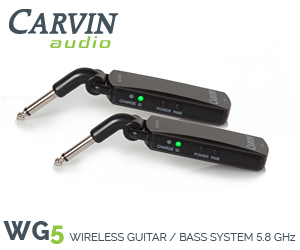7 Reasons Why Every Guitarist Should Own a 7-String
Marc Johnson | Feb 09, 2012 | Comments 9
Intimidated by an axe that moves beyond the borders of their six-string safety net, many players look at a seven-string as something of an anomaly, and if they close their eyes tight enough, 7-strings will eventually just go away.
Well, hate to break it to you, but they’re not going anywhere. And they shouldn’t.
And before anyone goes on a tirade about how there are too many bands doing the whole ‘down-tuned thing,’ keep in mind that there’s a reason that they’re tuning that low – because it sounds good.
With a little bit of practice, a seven-string can open up new horizons to your playing, and you’ll sound damn good doing it.
7’s are built to go low:
Sure, you can take your favorite Les Paul 6-string and permanently tune it to ‘B’ or ‘Drop B’ tuning, but unless you really want to turn a perfectly good guitar into firewood, you’ll have to do some adjustments.
First, unless you prefer playing on what feels like a rubber band, you have to move to a higher string gauge. And we’re talking going heavy. 12-54’s at least! And therein lies the rub. See when you go that thick, you have to file the nut and saddle slots to accommodate the thicker strings. You might even have to drill out a bigger hole in your fifth and sixth-string tuning gear. And guess what, if you want to go back to standard tuning, and thinner strings, you’ll have to buy all new saddles, gears, and a new nut. Then you’ll have to adjust the truss rod and the intonation on top of all of that. Unless, you’re a really good guitar tech, chances are that you’ll have to pay someone else to do all of the work.
In short, it’s going to cost you a bundle to get your 6 to do what a 7 can do right out of the box. And, TTK is all about saving money.
6’s just don’t sound the same:
We had this conversation earlier today in TTK’s Tone Lounge. Take a listen to bands that tune to ‘B’ on a 6-string and compare that to someone playing on a 7-string guitar. There is a difference! Generally, 7-strings are cleaner and more articulate where 6-stringers are muddier.
Some suspect that this is because of the pickups, and many pickup manufacturers are banking on that by releasing pickups for down-tuned guitars. Of course, that’s gonna be about $150 US for a new pair of ‘specialized’ pickups, son.
Others claim that the way that a 7-string resonates differently because it has more wood, surface area, and a broader harmonic resonance. I don’t know about all that scientific mumbo-jumbo, but there’s no doubt that there’s a difference in tone.
Expand Your Range!
There’s no rocket science behind this one. 7 strings are going to give you more options for voicing chords than 6 will. If you tune your 6 down to ‘B’, all you’re doing is moving the range of the instrument, not increasing it. Add a 7th string, on the other hand, and you got more places you can go.
For those of us who know our chords, that amounts to more voicings. Try stacking fifths off of the B on the fifth string second fret and throwing a moving bass line off of the low E and B strings. Or, take any barre chord rooting off the sixth string and slap a 5th in the bass by stretching your first finger just a bit further. Do the same thing with an F#5 by throwing a C# in the bass, and the resulting boom emanating from your axe can cure a case of E.D.
7-string guitars are all sophisticated and stuff:
In spite of what everyone else might be telling you, 7 strings are used in a wide variety of genres. Go to the Wiki page for 7 string guitars and the first thing you’ll see is a 7 string classical guitar. And The Tone King didn’t put it there just to make a point.
There’s a reason why classically influenced progressive players like Chris Broderick of Megadeth wield a wider axe. It’s because the broader range is conducive to classical voicings. It might surprise you to hear this, but Bach didn’t write Invention no. 4 for dueling shredding guitars. Otherwise he might’ve written it in tablature. Classical pieces were written for a variety of instruments that included a bigger spectrum of notes. Hell, what are you going to do if you want to play a Cello piece and suddenly you’re confronted with a low ‘C’? If you’re on a 7, it’s on the first fret of the 7th string, just so you know.
7’s can Jazz it up:
Jazz guys have been using 7’s for decades. Back in the 30’s, George Van Eps had a 7 built for him. In fact, his signature guitar might have been the first mass produced 7 on the market.
Other players saw what Van Eps was up to and quickly followed suit. Just like I mentioned earlier with the classical players, Jazz music wasn’t always written specifically for guitar. And since you’re trying to take a big song and play it on a little instrument, the more headroom you have, the better.
Contrary to the common argument, 7-strings aren’t just for head-bangers with gravelly voices. Classical, Jazz, Death Metal, and pretty much everything in-between, you’re going to find people strapping on an extra string. In short, you can find 7’s in just about any genre of music. Except for maybe Disco, but who cares about Disco.
You can play anything on a 7 that you can on a 6:
You can take any song that can be played on a 6 and play it on a 7, and most of the time, you wont even have to change your tuning. But, the opposite isn’t the case. In many cases, you’ll have to adjust a couple of fingerings to play something on a 7 that originated on a 6. But good luck trying to do the same thing when transposing songs from a 7 to a 6. You’d better hope that John Petrucci happened ignore the high ‘E’ string on that particular tune, because otherwise, you wont be playing any Dream Theater.
Learning how to transpose 6-string songs to 7-string also gets the gears in your head moving. It’s a workout. You know, like squats. Any good guitar player can play the same riff several different ways. And, they’ll usually try playing those riffs in different spots until it sounds just right.
Another weapon in your arsenal:
At TheToneKing.com, we’re all about utility. If a guitar can do something that none of the others can, then we’re gonna buy that bad boy. A good guitar arsenal is not just the same axe in fourteen different colors. (Although that can be cool, too) It’s a tool-kit. And, sometimes you need the right tool for the job.
It’s the same reason why you’ll always see a rack of guitars hanging out on stage next to your favorite performers. Standard tuning, drop ‘D’, 6-string, or 7; whatever they need for the next tune is already set up and ready to go. Players don’t have time to change their tunings on the fly, and the audience isn’t going to wait for them to drop that ‘E’ string down to a ‘B’.
Let’s face it. Every guitar player needs the right tools for the job. And, sometimes a 6-string just ain’t gonna cut it. If you’re looking to go low, you might be looking for a 7.
Tiny URL for this post:
Filed Under: Guitars
About the Author: Marc published his first novel Becoming in 2010. It’s a kick-ass book with monsters and dreams and stuff, and you should buy it. Since then, he’s written thousands of articles for TheToneKing.com, many of which have been picked up for circulation by manufacturers and other news outlets.
His next book, Drugs and Pancakes, should be available early 2014 if his alcoholic editor can find time to work on it in-between destroying his liver and screaming about punctuation. He graduated from Roosevelt University with honors, which means that he’s not as dumb as he looks.
He’s been playing guitar for over 25 years, which is almost twice as long as most of his students have been alive.




















